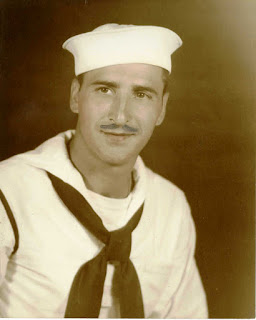This post was written by library volunteer Gail Denisoff.
A collection of artifacts and documents belonging to the late Joseph James Fazzone was donated to the historical society in 2010 a guide to this collection can be found here. Among the items is a wartime diary that Joseph kept as a Seaman 2nd Class serving aboard the Navy Destroyer USS Chauncey in the Pacific Theater during the second World War. The diary provides valuable insight into the day to day life of a seaman during the war.
A collection of artifacts and documents belonging to the late Joseph James Fazzone was donated to the historical society in 2010 a guide to this collection can be found here. Among the items is a wartime diary that Joseph kept as a Seaman 2nd Class serving aboard the Navy Destroyer USS Chauncey in the Pacific Theater during the second World War. The diary provides valuable insight into the day to day life of a seaman during the war.
Joseph James Fazzone was born to Italian immigrants, Antonio
and Angela Fazzone on March 19, 1911 in Scotia NY. He attended school until the 8th
grade and then went to work, eventually becoming proprietor of his own shoe
repair shop on Broadway in Schenectady. In
the 1930’s he met Bertha Marcinek whom he called “Squige”. They were married on August 16, 1936.
Joseph, who his wife called “Darlin”, and Bertha had no
children of their own but doted on nieces and nephews. Family photos show many family celebrations
and get togethers. Bertha worked as a
baseball sewer at the old Wilson-Western Baseball Factory on Hawthorne Street
in the Mont Pleasant section of Schenectady. Theirs was a very loving
relationship and diary entries reveal how much Joseph missed his wife while he
was serving overseas.
 |
| Joseph and Bertha at their home. |
Joseph ran his shoe repair business until he enlisted in the Navy in 1942. He saw action aboard the USS Chauncey whose home base was Pearl Harbor, Hawaii. He also served aboard the USS Randolph for a time. His diary entries are comprised of brief descriptions of daily travel or activity. The entry below describes Chauncey’s participation in air strikes on Wake Island on October 5&6, 1943. The Chauncey rescued three downed aviators during the mission.
 |
| Someone obviously thought that Joseph looked better with a mustache. |
 |
| Diary entry describing the air raids on Rabaul in New Guinea. |
Joseph was discharged from the Navy on October 26, 1945. After the war, he worked as a warehouse
supervisor for the Army Depot until his retirement in 1967. Joseph and Bertha enjoyed a long marriage
with presidential greetings from the Clintons and Bushes on anniversary
milestones. They celebrated their 70th
wedding anniversary in 2006. Two years
later, Bertha passed away at the age of 95.
Joseph died on January 29, 2010 at the age of 98.





